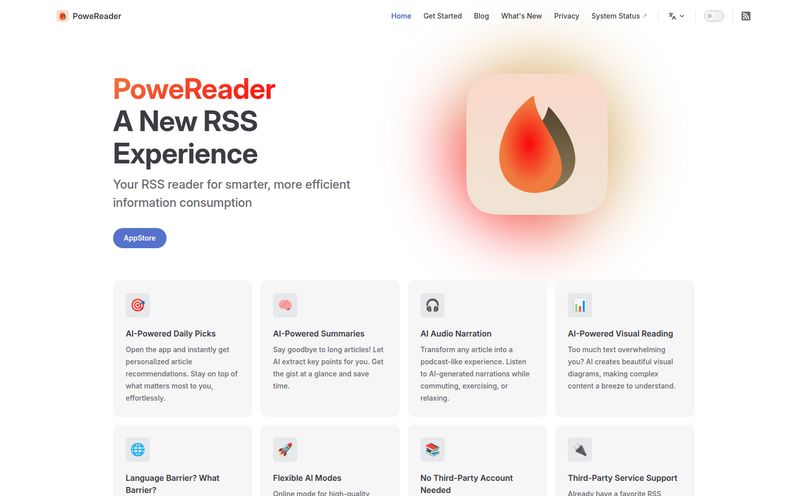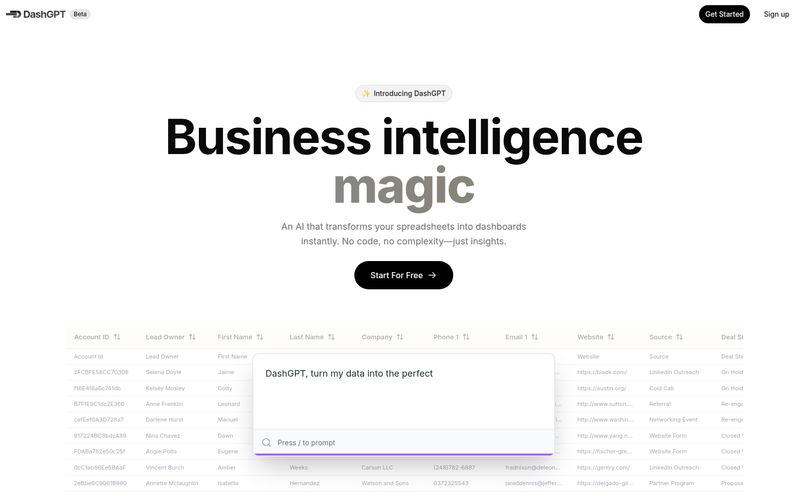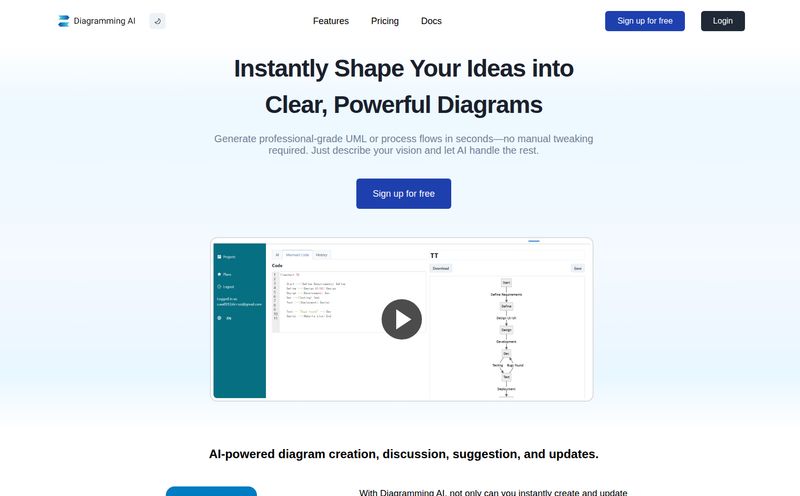Let me paint you a picture. It’s 4:45 PM on a Friday. You’re this close to logging off when a Slack message pings. “Hey, can you just quickly update the user flow diagram? We’ve added a new verification step.”
Ugh. You open up the old diagram file—you know the one. The one made in some clunky, web-based tool where every box is a slightly different size and the connecting lines look like a plate of spaghetti thrown at the wall. An hour later, you’re still wrestling with alignment guides and elbow connectors, and your weekend seems a million miles away. We’ve all been there.
For years, I just accepted this as the cost of doing business. Visual documentation was a necessary evil. Then I stumbled upon Mermaid Chart, and it felt like I'd found a secret passage out of diagram hell. It’s not just another diagramming tool; it’s a whole different way of thinking. And honestly? I don't think I can go back.
So, What Exactly is Mermaid Chart?
At its core, Mermaid Chart is a text-based diagramming tool. Instead of dragging and dropping shapes, you write simple, markdown-style code to describe your diagram, and the visual pops into existence right next to your text. It’s built on top of the wildly popular open-source project, Mermaid.js, which you’ve probably already seen rendering diagrams in GitHub, GitLab, or Notion.
Think of it as “diagrams as code.” You can create flowcharts, sequence diagrams, Gantt charts, user journey maps, C4 models… you name it. And because it's just text, you can version control it with Git, collaborate on it easily, and keep your documentation perfectly in sync with your actual systems. It just makes sense.

Visit Mermaid Chart
Why I'm Ditching Drag-and-Drop for Good
This isn't just about a new, shiny toy. Switching to a text-based workflow with Mermaid Chart has had some serious, tangible benefits for me and my team. It boils down to a few key things.
Speed is the Name of the Game
Let's be real, writing `A --> B` is infinitely faster than clicking a box, dragging it, clicking a text tool, typing in it, clicking a connector, and dragging that connector between two nodes. It’s the difference between typing a sentence and building it with alphabet blocks. Once you get the hang of the basic syntax—which is surprisingly simple—you can churn out complex diagrams in a fraction of the time. This is a huge win for anyone in an agile environment where things change, you know, constantly.
Collaboration That Doesn't Make You Want to Cry
Trying to have two people work on a traditional diagram at once is a recipe for disaster. “Did you save your version?” “Wait, don’t move that, I was working on that section!” It’s a mess. Mermaid Chart brings Google Docs-style real-time collaboration to the party. You can see your teammate’s cursor, watch them type, and build out a system architecture together, live. It also has version history, so you can roll back to a previous iteration if someone (not naming names) accidentally deletes half the flowchart.
The AI Magic Wand
Okay, this is where it gets really cool. Mermaid Chart has an integrated AI feature that is just… chef’s kiss. You can literally just write a prompt like, “Create a sequence diagram for a user logging into a website, checking their dashboard, and logging out,” and it will generate the code for you. It’s not always perfect, but it gets you 80-90% of the way there in seconds. It can even take a messy, broken diagram you’ve half-written and use AI to repair it. For me, this feature alone is worth the price of admission.
“It’s like having a junior dev who’s an expert in diagramming, ready to help you out at a moment’s notice. It completely changes the friction of creating documentation.”
The Open Source Heartbeat: Mermaid.js vs. Mermaid Chart
Now, some of you eagle-eyed developers might be thinking, “Wait, I can already use Mermaid for free in my markdown files!” And you’re absolutely right. The Mermaid.js library is open-source and amazing. I’ve used it for years.
So what's the difference? Mermaid Chart is the commercial platform built around that open-source core. It adds all the good stuff that’s hard to manage on your own: the secure cloud storage, the real-time collaboration, version history, team management, the slick visual editor, and of course, the powerful AI tools. Think of it like Git vs. GitHub. Git is the underlying tech; GitHub is the platform that makes it easy and powerful for teams to use.
Let's Talk Turkey: Mermaid Chart Pricing
Alright, the all-important question: what’s this going to cost me? The pricing structure is pretty straightforward and, in my opinion, quite fair for the value it provides.
| Plan | Price | Who It's For |
|---|---|---|
| Free | $0 / month | Individuals or small teams just getting started. It's got the basic features but is limited in use. A great way to test the waters. |
| Pro | $6.67 / team member / month (billed annually) | Professional teams who need this in their daily workflow. This unlocks advanced features, unlimited diagrams, and the full power of the platform. |
| Enterprise | $17 / team member / month (billed annually) | Large organizations with needs for advanced security, dedicated support, and SSO. The whole shebang. |
For most serious users and teams, the Pro plan is the sweet spot. The jump from the free plan's limitations to the Pro plan's unlimited use is significant. Given the time it saves, the $80 per year feels like a bargain. You can check out the full details on their official pricing page.
Is There a Catch? The Not-So-Perfect Parts
No tool is perfect, and I want to give you the full picture. The biggest hurdle is the one I've already mentioned: the learning curve. If you've never written a line of code or markdown, it might feel a little alien at first. It’s not a steep curve, but it’s a curve nonetheless. You have to be willing to trade the immediate familiarity of a GUI for the long-term speed and power of text.
The other downside is that the free plan is quite limited. It's enough to get a taste, but if you plan on using it for real project work, you'll likely hit the usage ceiling pretty quickly. It's a classic freemium model, which is fine, but something to be aware of.
Who is This Really For?
So, who should drop what they’re doing and try Mermaid Chart right now? In my experience, it’s a perfect fit for:
- Software Developers & DevOps Engineers: Keeping diagrams next to your code, in the same repository? It's a dream come true for maintaining accurate documentation.
- Technical Project Managers: Quickly whipping up Gantt charts and flowcharts for planning sprints and explaining processes is a superpower.
- Technical Writers: Embedding up-to-date, easy-to-edit diagrams directly into your documentation is a massive workflow improvement.
- Agile Teams: The speed and collaborative nature are perfect for whiteboarding sessions and sprint planning.
If your job involves explaining complex systems, and you're comfortable with text-based tools, this is for you. If you live and die by your mouse and prefer a purely visual approach, it might not be your cup of tea. And that's okay too!
Frequently Asked Questions about Mermaid Chart
- 1. Can I really create any kind of diagram with Mermaid Chart?
- It supports a huge variety of the most common diagram types used in tech and business, including flowcharts, sequence diagrams, Gantt charts, class diagrams, state diagrams, pie charts, and user journey maps. It's always expanding, but it covers the vast majority of needs.
- 2. Is Mermaid Chart actually free to use?
- Yes, there is a free plan! It offers basic features with some limitations on usage. It's perfect for trying out the platform. For unlimited use and advanced features like the AI tools, you'll need one of the paid plans (Pro or Enterprise).
- 3. How is Mermaid Chart different from just using the open-source Mermaid.js?
- Mermaid.js is the core rendering engine. Mermaid Chart is the full-featured platform built on top of it. It adds a user-friendly editor, cloud storage, real-time collaboration, versioning, team management, and AI-powered generation and repair tools.
- 4. Is the markdown-style code difficult to learn?
- If you're familiar with markdown, you'll pick it up very quickly. If you're new to it, there's a slight learning curve, but the syntax is very intuitive and human-readable. Plus, the AI generator can write the code for you, which is a great way to learn.
- 5. Can I integrate Mermaid Chart with other tools?
- Yes, one of its strengths is its ability to integrate with other software. There are plugins and integrations for popular tools like Confluence, Jira, and VS Code, allowing you to embed and edit your diagrams where you already work.
- 6. Is it better than a tool like Visio or Lucidchart?
- It's not about being strictly 'better', but about being different. For developers and technical teams who value speed, version control, and keeping docs close to code, Mermaid Chart is often a much better fit. For purely visual, design-heavy work, a traditional tool might still be preferred by some.
The Final Verdict
Look, I get paid to analyze trends, and I can tell you that the “everything-as-code” movement isn’t slowing down. We have infrastructure-as-code, configuration-as-code, and now, with tools like Mermaid Chart, we have diagrams-as-code. It's a more robust, maintainable, and developer-friendly way to work.
For me, Mermaid Chart has successfully turned one of the most tedious parts of my job into something that’s actually... kind of fun? It's fast, it's powerful, and it integrates beautifully into the modern tech stack. If you’ve ever felt the pain of the 4:45 PM diagram request, do yourself a favor and give it a try. You might just become a convert, too.
References and Sources
- Mermaid Chart Official Website: https://www.mermaidchart.com/
- Mermaid Chart Pricing Page: https://www.mermaidchart.com/pricing
- Mermaid.js Open Source Project: https://mermaid.js.org/



